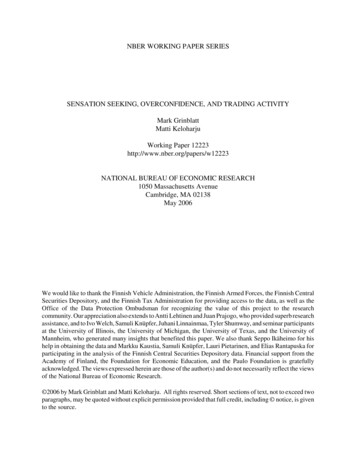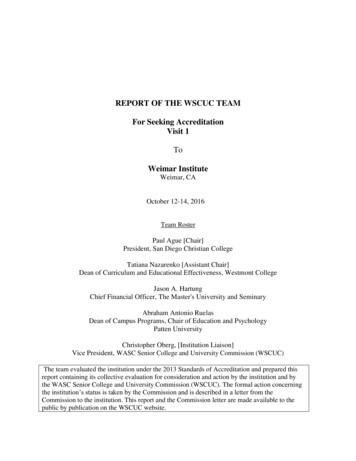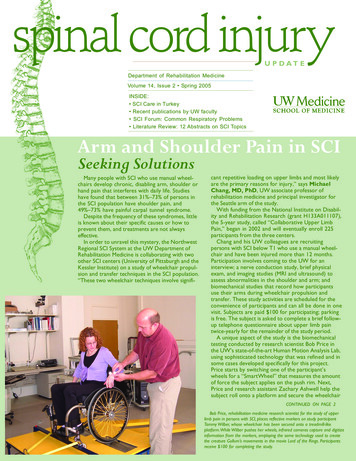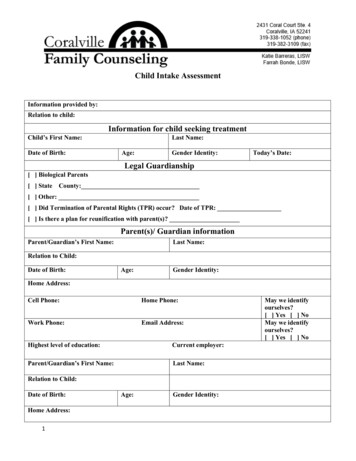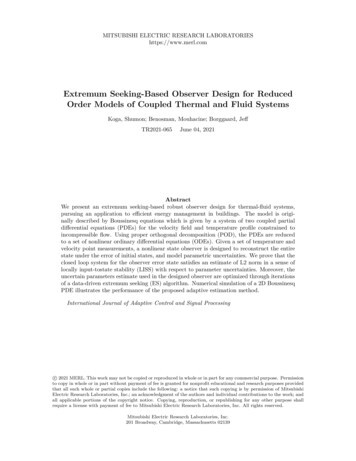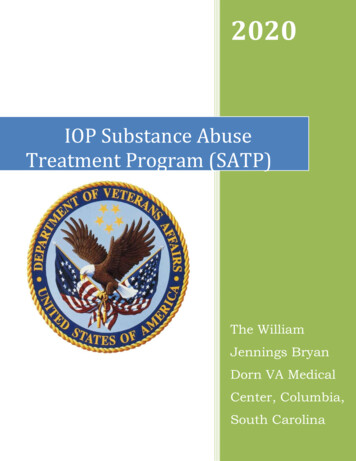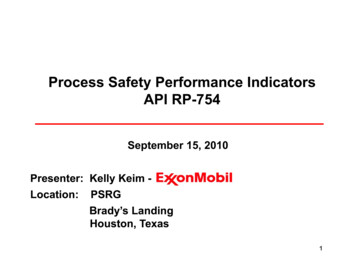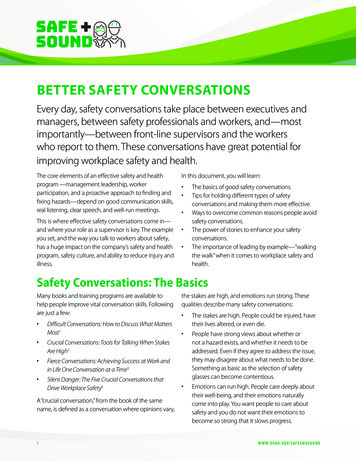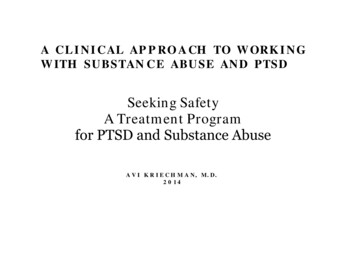
Transcription
A C L I NICAL APPRO A CH TO WORKINGWITH SUBSTAN C E ABUSE AND PTSDSeeking SafetyA Treatment Programfor PTSD and Substance AbuseA V I K R I E C H M A N, M. D.2014
Seeking Safety is an evidenced based treatmentmodel that treats the co-occurringdiagnosis’s of PTSD and Substance Abuse Treatment focuses on both diagnosesEach condition is seen as adversely affecting the otherThis model creates a balance between exposure to dualtreatment issues while avoiding exposure to significant traumamemoriesNajavits, L. M., (2002) Seeking Safety A Treatment Manual for PTSD and Substance Abuse
PTSD and Substance Abuse:A Patient’s Perspective
Seeking Safety“As far back as I can remember someone wasabusing me: my brother, my father, my distantmother. By the time I was 12, I was falling intoabusive relationships with men, many whotook advantage of a young desperate girl. I hadbegun to treat myself as I had been treated, asunimportant outside of giving people what theywanted from me. To cope with the memoriesand repeated traumas, I was using drugssupplied by people who professed to love me.”
Seeking Safety“The more I use, the more I won’t feel anything.The pain is so bad you just want to die. There isno other way out. If you talk about it, it will hurttoo much. So instead, keep it a secret. No onewill know.”Najavits, L. M., (2002) Seeking Safety A Treatment Manual for PTSD and Substance Abuse.New York: Guilford
Seeking Safety“Night time is the absolute worst. I worryabout my friends who are still there. Ican’t stand noise. I can’t stand silence.”
Defining PTSD7 Post Traumatic Stress Disorder is the result of an event or seriesof events that were acutely damaging to the emotional, physical,and psychological well being of an individual.-The traumatic experience would be defined as occurring out of thecontrol of the traumatized individual-The traumatized individual could have witnessed or been directlyinvolved in the event-The event outside of the individual’s control would be experienced as aphysical threat (e.g., physical/sexual abuse, war combat, seeing someonekilled or abused, surviving catastrophic events such as a hurricane or caraccident)Najavits, L. M., (2002) Seeking Safety A Treatment Manual for PTSD and Substance Abuse.New York: Guilford
ResponsesResponses to the Traumatic Event: Involve intense helplessness, fear, or horror Children often exhibit agitation, disorganizedfunctioning and problem behaviorNajavits, L. M., Seeking Safety A Treatment Manual for PTSD and Substance Abuse.New York: Guilford
SymptomsPTSD Symptoms:(symptoms persist for more than a month) Intrusion: The trauma comes back into memory even with attempts toavoid thinking about the event(s)-flashbacks, nightmares, images Avoidance: Numbing, feeling detached, avoiding reminders of thetrauma Arousal: Feeling “hyped up”- startle response, hyper-vigilant, sleep disturbance, anger, crying Lowered functioning: Problems with relationships, work, or othermajor life areasNajavits, L. M., (2002) Seeking Safety A Treatment Manual for PTSD and Substance Abuse.New York: Guilford
Types of PTSD Simple PTSDFrom a single incident (such as a car accident, orweather related catastrophe), usually as an adult Complex PTSDResults from repeated incidents such as domesticviolence, childhood abuse, combat tour of dutyNajavits, L. M., (2002) Seeking Safety A Treatment Manual for PTSD and Substance Abuse.New York: Guilford
PTSD Symptoms Numbness Self harm Suicide Loss of Faith Dissociation Loss of Trust Memory Health Sexuality Security Concerns Shame Anger Anxiety Guilt Feeling Damaged Najavits, L. M., (2002) Seeking Safety A Treatment Manual for PTSD and Substance Abuse.GuildfordNew York:
StatisticsPTSD Prevalence Women – 51% experience trauma, with 10%developing PTSD Men – 61% experience trauma, with 5%developing PTSDNajavits, L. M., (2002) Seeking Safety A Treatment Manual for PTSD and Substance Abuse.New York: Guilford
PTSD and Substance AbuseCultural Issues In the US rates of PTSD do not differ by race(Kessler et al., 1995) In the US Hispanics and African–Americans havelower substance abuse rates than Caucasians Native Americans have higher substance abuserates than Caucasians.Najavits, L. M., (2002) Seeking Safety A Treatment Manual for PTSD and Substance Abuse.New York: Guilford
PrevalencePrevalence of the dual diagnosis of PTSD andSubstance Abuse Co-occurring diagnosis of PTSD and Substance Abuse inaddiction treatment facilities - 12% - 34% Women in substance treatment – 30% - 59% Men in substance treatment – 11% - 38%Typically PTSD symptoms preceded the onset of substance abuse.Najavits, L. M., (2002) Seeking Safety A Treatment Manual for PTSD and Substance Abuse.New York: Guilford
PTSD ResponseWhy do Some Individuals Exposed to TraumaDevelop PTSD and Others Do Not Much is unknown Personality may influence PTSD response Life situation during and after trauma event maycontribute Quality of lifetime relationshipsNajavits, L. M., (2002) Seeking Safety A Treatment Manual for PTSD and Substance Abuse.New York: Guilford
DSM-5 PTSD criteriaTrauma that is re-experienced, avoided, associated withsymptoms of arousal/reactivity and associated withnegative cognitions and mood- negative beliefs/expectations about self or the world- distorted blame of self/others for causing trauma or for resulting-consequencesnegative trauma-related emotions (fear, horror, anger, guilt, shame)feeling alienated from othersinability to experience positive emotionsdiminished interest in pre-traumatic activities
PTSD and Substance AbuseLinks Between PTSD and Substance Abuse Two main themes of both disorders are secrecy and control Each of the disorders makes the other more likely Both diagnoses have higher rates of personality disorders PTSD symptoms widely reported to become worse withinitial abstinence Both situations produce a profound need to be in an alteredstateNajavits, L. M., (2002) Seeking Safety A Treatment Manual for PTSD and Substance Abuse.New York: Guilford
Treatment Issues In a study of 77 women with current PTSD andsubstance dependence most of the treatment focusedon substance abuse. 80% would choose to treat PTSD (either combinedwith substance abuse or alone) Fewer than 20% would choose substance abuse treatment aloneNajavits, L. M., (2002) Seeking Safety A Treatment Manual for PTSD and Substance Abuse.New York: Guilford
Current Treatment NeedsAttention to Co-occurring Treatment Needs Most substance abuse(SA) patients are not sufficientlyassessed for PTSD issues even after multiple addictiontreatments Most SA patients are not informed of the PTSD diagnosis Most substance abuse facilities do not endorse co-occurringtreatment for SA and PTSD Most mental health providers do not routinely screen PTSDpatients for substance abuseNajavits, L. M.,(2002) Seeking Safety A Treatment Manual for PTSD and Substance Abuse.New York: Guilford
History of Treating PTSDKnowledge About PTSD Relatively New First emerged in the study of soldiers returningfrom combat Later broader application to other types of abuseemerged 1980 PTSD added to the official list of psychiatricdisordersNajavits, L. M.,(2002) Seeking Safety A Treatment Manual for PTSD and Substance Abuse.New York: Guilford
ModelLisa Najavits Seeking Safety Model Emphasizes importance of treating PTSD andsubstance abuse concurrently Establishes clear clinical guidelines for combiningPTSD and substance abuse treatment Utilizes homework and the practice of new behaviors Incorporates Cognitive Behavioral TherapyNajavits, L. M.,(2002) Seeking Safety A Treatment Manual for PTSD and Substance Abuse.New York: Guilford
Lisa Najavits Model Encourages understanding of relationship betweenpatient’s PTSD trauma and substance abuse Emphasizes skill development and improved copingresponses It is the first treatment for PTSD and substanceabuse with published outcome results (Najavits etal., 1997, 1998e)Najavits, L. M.,(2002) Seeking Safety A Treatment Manual for PTSD and Substance Abuse.New York: Guilford
Treatment ManualTreatment manual comprises: Psychotherapeutic treatment approach for groups and individuals25 topic areas addressing recovery andcoping skills developmentEach of the 25 topic areas are evenly divided amongcognitive, behavioral, and interpersonal domainsEach topic area includes a safety oriented skill relevantto both PTSD and substance abuseEach topic is independent of the othersNajavits, L. M.,(2002) Seeking Safety A Treatment Manual for PTSD and Substance Abuse.New York: Guilford
Treatment Topics:Seeking Safety SafetyPTSD: Taking Back Your PowerDetaching from Emotional Pain(Grounding)When Substances Control YouAsking for HelpTaking Good Care of YourselfCompassionRed and Green FlagsHonestyRecovery ThinkingIntegrating the Split Self Najavits, L.M., (2002) Seeking Safety A TreatmentManual for PTSD and Substance Abuse. New York:GuilfordCommitmentCreating MeaningCommunity ResourcesSetting Boundaries in RelationshipsDiscoveryGetting Others to Support YourRecoveryCoping with TriggersRespecting Your TimeHealthy RelationshipsSelf-NurturingHealing from AngerThe Life Choices Game (Review)Termination
Stage ModelNajavits’ Three Stage Model of Recovery1. Safety2. Mourning3. Reconnections Safety Stage is the initial process of Najavits’ treatment model andis the treatment stage presented in this training. Mourning and Reconnections are later stages of recovery that areinitiated in therapy work separate from the Seeking Safety SkillsGroup.
Introduction to Seeking Safety Manual:PrinciplesSeeking Safety is Based on Five Central Principles:1. Safety as an ongoing priority in treatment2. Integrated treatment of PTSD and substance abuse3. Focus on restoring ideals that have been lost4. Four content areas: cognitive, behavioral, interpersonal, and casemanagement5. Attention to therapist processes (building an alliance, compassion forpatients’ experience, giving patients control whenever possible,modeling what it means to “try hard” by meeting patients more thanhalfway, getting feedback about their genuine reactions to treatment)
What is and is Not Part of Seeking SafetyAdditional features of Seeking Safety: Focus on potential rather than pathology Use of simple, everyday words Emphasis on practical solutions Relating the material of current and specific problems in patients’ lives Making best use of time availableNOT part of Seeking Safety Additional features: Exploration of past trauma and trauma memories Interpretive psychodynamic work (processing of patient’s relationship withthe therapist or group members with each other; exploration of intrapsychicmotives or dynamic insights)
Protecting Therapists as well as Patients “By helping their patients move toward safety, therapists areprotecting themselves from the sequelae of treatment that couldmove too fast without a solid foundation: worry over the patients’well-being, vicarious traumatization, medico- legal liability, anddangerous transference and countertransference dilemmas that maybe evoked by inappropiate treatment.”
Safety – Principle ElementsPrinciples Discontinuing Use – Ties to recovery traditions andis compatible with Harm Reduction modelsReducing Suicidal Risks – Emphasizes copingresponses and skills in managing intense emotionsMinimizing Risks – Self care regarding medical,emotional, physical, behavioral needs throughcreating pro-active behaviorsNajavits, L. M.,(2002) Seeking Safety A Treatment Manual for PTSD and Substance Abuse.New York: Guilford
PrinciplesSafety – Principle Elements Letting Go of Dangerous Relationships – Addressingdomestic violence, using friends/significant others Gaining Control Over Extreme Symptoms – Copingwith dissociation, flashbacks and related processes Stopping Self Harm – Reducing cutting and otherforms of self injuryNajavits, L. M.,(2002) Seeking Safety A Treatment Manual for PTSD and Substance Abuse.New York: Guilford
Links Between Substance Abuse and PTSDRecovery Tasks which are common to both PTSD andSubstance Abuse treatment Safety elements within the management of PTSD symptomsreflect traditional safety elements in substance abuserecovery: EducationPresent time orientationAssessing the impact of conditionDealing with urges and cravingsFocus on self careAttention to relapse preventionNajavits, L. M.,(2002) Seeking Safety A Treatment Manual for PTSD and Substance Abuse.New York: Guilford
Stage TreatmentSafety Stage Goals:1. Develop commitment to practicing safety2. Master coping skills (responses to symptoms)3. Utilize safety planning (prevention)4. Report unsafe behaviors (asking for help)5. Utilize Safety contract (response to urges)Najavits, L. M.,(2002) Seeking Safety A Treatment Manual for PTSD and Substance Abuse.New York: Guilford
Principle FivePrinciple 5: Attention to therapist processes Research indicates that patients with substance abuse in particular, that theeffectiveness of treatment is determined as much or more by the therapist as bytherapeutic orientation or patient characteristics Emphasize building on positive therapist’ processes – building an alliance,compassion for patients’ experience, giving patients control whenever possible,modeling what it means to “try hard” by meeting patients more than halfway Solicit genuine feedback from patients about their treatment experiencesNajavits, L.M.,(2002) Seeking Safety A Treatment Manual for PTSD and Substance Abuse. New York: Guilford
Principle FivePrinciple 5: therapist processes Attention to problematic counter-transference reactions Harsh confrontation Voyeurism Inability to hold patients accountable – misguided sympathy (ratherthan encouraging accountability and growth) Allowing patients to be scapegoated in group treatment Becoming a victim Identification with patient’s PTSD which can result in excessivesupport and overindulgence with patient’s vulnerability Being afraid of patientsNajavits, L. M.,(2002) Seeking Safety A Treatment Manual for PTSD and Substance Abuse.New York: Guilford
Introduction to Treatment FormatTreatment Approach and Group Orientation Focus on Safety as Primary Theme Najavits’ model emphasizes “safety skills” in the management of PTSDsymptoms, feelings of emotional turmoil, and self doubtInteractions with clients focus on supporting and facilitating safetythemes in making behavioral choices, in response to emotions andreactions to situationsIn addition to Cognitive/Behavioral approaches, the teaching ofgrounding skills is used to enable the client to self sooth and disengagefrom destructive urges, emotional pain, and feelings of beingoverwhelmed.Najavits, L. M.,(2002) Seeking Safety A Treatment Manual for PTSD and Substance Abuse . New York: Guildford
Introduction to Treatment FormatSession Format:(handout: Safety Topic)Introduction1. Check-in: Find out how the client is doing2. The Quotation: To help emotionally engage patients in session3. Session Topic: To connect topic meaningfully to patient’s experience4. Group (Grounding techniques and Coping Sheets may be used)5. Commitment Sheets6. Check-out: To reinforces patients’ progress and give therapist feedback7. Feedback Form (optional)Najavits, L. M., (2002) Seeking Safety A Treatment Manual for PTSD and Substance Abuse. New York: Guildford
Check-In Check-In1.How are you feeling?2.What good coping have you done? (Patients generate “good coping”not therapists: “People usually do something right– what was it foryou?” “Look at Safe Coping Skills list – did you do any of those thisweek?”)3.Any substance use or other unsafe behavior? (any unsafe incidentsince the last session needs to be prioritized in the current session)4.Did you complete your commitment?5.Community resource update
Check-Out Check-Out1.Name one thing you got out of today’s session (and any problemswith the session)2.What is your new commitment?3.What community resource will you call?
Core Concepts of Treatment Stay safeRespect yourselfUsing coping – not substances – to escape the painMake the present and future better than the pastLearn to trustTake good care of your bodyGet help from safe peopleTo heal fully from PTSD, become substance-freeIf one method doesn’t work, try something elseNever, never, never, never, never, never, never, never, never give up!
If You Have Only One or a Few SessionsConsider one or more of the following topics: Safety PTSD: Taking Back Your Power When Substances Control You Detaching from Emotional Pain (Grounding) Asking for Help
Seeking Safety Topics Intro to treatment, getting to know patient, assessing case management needsPatients explore what Safety means to them (list of 80 Safe Coping Skills)PTSD: what it is, link to substance use, using compassion to take back powerGrounding (mental, physical, soothing) to help detach from emotional painWhen Substances Control YouAsking for help: need for help and how to obtain itTaking Good Care of Yourself: self-careCompassion: loving stance toward self produces lasting changeRed and Green Flags: signs of danger and safety; creating a Safety PlanHonesty: role of honesty in recovery and when it’s safe to be honestRecovery Thinking: List Your Options, Create a New Story, Make a Decision,ImagineIntegrating the Split Self: striving for integration
Seeking Safety Topics Commitment: making and keeping promises to self and othersCreating Meaning: finding meanings that are healing in recoveryCommunity Resources to aid recovery and how to evaluate themSetting (Healthy) Boundaries in RelationshipsDiscovery to stay open to experiences and new knowledgeGetting Others to Support Your Recovery, including inviting safe familymember or friend to attend sessionCoping with Triggers: how to change people, places, and thingsRespecting Your Time to make recovery highest priorityHealthy Relationships(Safe) Self-NurturingHealing from Anger: constructive vs. destructive angerThe Life Choices Game focusing on constructive copingTermination including finalizing aftercare plans
Case Management Needs HousingIndividual TherapyPsychiatric MedicationHIV Testing/CounselingJob/Volunteer Work/SchoolSelf-Help Groups/Group TherapyDay TreatmentDetox/Inpatient CareParenting Skills/Resources forChildren Medical CareFinancial Assistance (food stamps,Medicaid)Leisure TimeDomestic Violence/AbusiveRelationshipsImpulses to Harm Self or OthersAlternative treatment (meditation,acupuncture)Self-Help Books and Materials
GroundingTopic: Detaching From Emotional PainIncludes: Session Format Clinical/Counseling Process of Session Grounding Techniques Closing Session
Example TopicRelate Topic to Current and Specific Problems This involves the discussion, exploration and clinicalgroup work phase of the session Helpful to connect to issues and themes that may haveemerged during check-in, or in past groups Example for the topic of Detaching From Emotional Pain: Sharing of personal aspects of emotional pain, combinedwith the teaching and discussion of grounding techniquesDevelop a commitment to practice the techniques betweensessionsNajavits, L. M.,(2002) Seeking Safety A Treatment Manual for PTSD and Substance Abuse.New York: Guilford
Special Treatment FocusOptimism Focus on the strengths of the patient Focus on the present and future opportunities Try, try againNajavits, L. M.,(2002) Seeking Safety A Treatment Manual for PTSD and Substance Abuse.New York: Guilford
Treatment ModalitiesSeeking Safety works: In group or individual treatment Inpatient and outpatient settings In long term residential care For men and women For patients who do not necessarily meet formalcriteria for current PTSD and substance abuse With other ongoing treatment approachesNajavits, L. M.,(2002) Seeking Safety A Treatment Manual for PTSD and Substance Abuse.New York: Guilford
Conducting a SessionSession Therapeutic Style Direct process without taking charge Apply 80/20 rule: patients talk 80% of the time, therapists 20% Ask provocative questions – “How might this apply to your PTSDand substance use” Relate material to current and specific problems in patients’ lives Process barriers and obstacles Refer to Coping and Commitment SheetsNajavits, L. M.,(2002) Seeking Safety A Treatment Manual for PTSD and Substance Abuse.New York: Guilford
Frequently asked questions:What is the strongest theme of Seeking Safety? Empowering patients to have faith, and believe thattheir lives can get better by initiating safety as thecentral theme in their first stage of recovery :Instillation of HopeNajavits, L. M.,(2002) Seeking Safety A Treatment Manual for PTSD and Substance Abuse.New York: Guilford
Contact information Web sitewww.seekingsasfety.org
Women – 51% experience trauma, with 10% developing PTSD Men – 61% experience trauma, with 5% developing PTSD. Najavits, L. M., (2002) Seeking Safety A Treatmen
